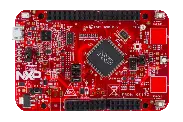NXP FRDM-KE17Z
Overview
The FRDM-KE17Z is a development board for NXP Kinetis KE1xZ 32-bit MCU-based platforms. The FRDM-KE17Z contains a robust TSI module with up to 50 channels which makes this board highly flexible for touch keys. Offers options for serial communication, flash programming, and run-control debugging.

FRDM-KE17Z (Credit: NXP)
Hardware
MKE17Z256VLL7 MCU (up to 72 MHz, 256 KB flash memory, 48 KB SRAM, and 100 Low profile Quad Flat Package (LQFP))
3.3 V or 5 V MCU operation
6-axis FXOS8700CQ digital accelerometer
3-axis digital angular rate gyroscope
One RGB LED
Two user push-buttons
Thermistor
Two capacitive touchpads
Flex I/O pin header
For more information about the KE1xZ SoC and the FRDM-KE17Z board, see these NXP reference documents:
Supported Features
The frdm_ke17z board configuration supports the following hardware features:
Interface |
Controller |
Driver/Component |
|---|---|---|
NVIC |
on-chip |
nested vector interrupt controller |
SYSTICK |
on-chip |
systick |
PINCTRL |
on-chip |
pinctrl |
GPIO |
on-chip |
gpio |
UART |
on-chip |
uart |
The default configuration can be found in the defconfig file: boards/nxp/frdm_ke17z/frdm_ke17z_defconfig.
Other hardware features are not currently supported by the port.
System Clock
The KE17Z SoC is configured to run at 48 MHz using the FIRC.
Serial Port
The KE17Z SoC has three UARTs. UART0 is configured for the console.
Programming and Debugging
Build and flash applications as usual (see Building an Application and Run an Application for more details).
Configuring a Debug Probe
A debug probe is used for both flashing and debugging the board. This board is configured by default to use Linkserver.
Early versions of this board have an outdated version of the OpenSDA bootloader and require an update. Please see the DAPLink Bootloader Update page for instructions to update from the CMSIS-DAP bootloader to the DAPLink bootloader.
Option 1: Linkserver
Install the LinkServer Debug Host Tools and make sure they are in your search path. LinkServer works with the default CMSIS-DAP firmware included in the on-board debugger.
Linkserver is the default for this board,
west flashandwest debugwill call the linkserver runner.
west flash
External JLink: J-Link External Debug Probe
Install the J-Link Debug Host Tools and make sure they are in your search path.
Attach a J-Link 10-pin connector to J14. Check that jumpers J8 and J9 are
off (they are on by default when boards ship from the factory) to ensure
SWD signals are disconnected from the OpenSDA microcontroller.
Use the -r jlink option with west to use the jlink runner.
west flash -r jlink
Configuring a Console
Regardless of your choice in debug probe, we will use the OpenSDA microcontroller as a usb-to-serial adapter for the serial console.
Connect a USB cable from your PC to J6.
Use the following settings with your serial terminal of choice (minicom, putty, etc.):
Speed: 115200
Data: 8 bits
Parity: None
Stop bits: 1
Flashing
Here is an example for the Hello World application.
# From the root of the zephyr repository
west build -b frdm_ke17z samples/hello_world
west flash
Open a serial terminal, reset the board (press the SW1 button), and you should see the following message in the terminal:
*** Booting Zephyr OS build xxxxxxxxxxxx ***
Hello World! frdm_ke17z/mke17z7
Debugging
Here is an example for the Hello World application.
# From the root of the zephyr repository
west build -b frdm_ke17z samples/hello_world
west debug
Open a serial terminal, step through the application in your debugger, and you should see the following message in the terminal:
*** Booting Zephyr OS build xxxxxxxxxxxx ***
Hello World! frdm_ke17z/mke17z7